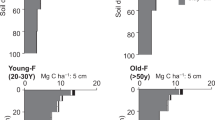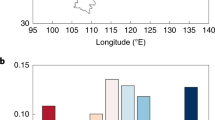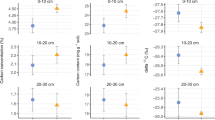Abstract
Tropical savannas have been increasingly targeted for carbon sequestration by afforestation, assuming large gains in soil organic carbon (SOC) with increasing tree cover. Because savanna SOC is also derived from grasses, this assumption may not reflect real changes in SOC under afforestation. However, the exact contribution of grasses to SOC and the changes in SOC with increasing tree cover remain poorly understood. Here we combine a case study from Kruger National Park, South Africa, with data synthesized from tropical savannas globally to show that grass-derived carbon constitutes more than half of total SOC to a soil depth of 1 m, even in soils directly under trees. The largest SOC concentrations were associated with the largest grass contributions (>70% of total SOC). Across the tropics, SOC concentration was not explained by tree cover. Both SOC gain and loss were observed following increasing tree cover, and on average SOC storage within a 1-m profile only increased by 6% (s.e. = 4%, n = 44). These results underscore the substantial contribution of grasses to SOC and the considerable uncertainty in SOC responses to increasing tree cover across tropical savannas.
This is a preview of subscription content, access via your institution
Access options
Access Nature and 54 other Nature Portfolio journals
Get Nature+, our best-value online-access subscription
$29.99 / 30 days
cancel any time
Subscribe to this journal
Receive 12 print issues and online access
$259.00 per year
only $21.58 per issue
Buy this article
- Purchase on Springer Link
- Instant access to full article PDF
Prices may be subject to local taxes which are calculated during checkout



Similar content being viewed by others
Data availability
Data supporting the results can be found at Dryad Digital Repository (https://doi.org/10.5061/dryad.c59zw3rbg). Source data are provided with this paper.
References
Bastin, J.-F. et al. The global tree restoration potential. Science 365, 76–79 (2019).
Laestadius, L., Buckingham, K., Maginnis, S. & Saint-Laurent, C. Before Bonn and beyond: the history and future of forest landscape restoration. Unasylva 66, 11 (2015).
Grace, J., José, J. S., Meir, P., Miranda, H. S. & Montes, R. A. Productivity and carbon fluxes of tropical savannas. J. Biogeogr. 33, 387–400 (2006).
Abreu, R. C. R. et al. The biodiversity cost of carbon sequestration in tropical savanna. Sci. Adv. 3, e1701284 (2017).
Tilman, D. et al. Fire suppression and ecosystem carbon storage. Ecology 81, 2680–2685 (2000).
Zhou, Y. et al. Limited increases in savanna carbon stocks over decades of fire suppression. Nature 603, 445–449 (2022).
Veldman, J. W. et al. Comment on ‘The global tree restoration potential’. Science 366, eaay7976 (2019).
Bai, Y. & Cotrufo, M. F. Grassland soil carbon sequestration: current understanding, challenges and solutions. Science 377, 603–608 (2022).
Zhou, Y., Boutton, T. W. & Wu, X. B. Soil carbon response to woody plant encroachment: importance of spatial heterogeneity and deep soil storage. J. Ecol. 105, 1738–1749 (2017).
Hughes, R. F. et al. Changes in aboveground primary production and carbon and nitrogen pools accompanying woody plant encroachment in a temperate savanna. Glob. Chang. Biol. 12, 1733–1747 (2006).
Jackson, R. B., Banner, J. L., Jobbágy, E. G., Pockman, W. T. & Wall, D. H. Ecosystem carbon loss with woody plant invasion of grasslands. Nature 418, 623–626 (2002).
Barger, N. N. et al. Woody plant proliferation in North American drylands: a synthesis of impacts on ecosystem carbon balance. J. Geophys. Res. Biogeosci. https://doi.org/10.1029/2010JG001506 (2011).
Pellegrini, A. F. A. et al. Repeated fire shifts carbon and nitrogen cycling by changing plant inputs and soil decomposition across ecosystems. Ecol. Monogr. 90, e01409 (2020).
Lloyd, J. et al. Contributions of woody and herbaceous vegetation to tropical savanna ecosystem productivity: a quasi-global estimate. Tree Physiol. 28, 451–468 (2008).
Guo, L. B. & Gifford, R. M. Soil carbon stocks and land use change: a meta analysis. Glob. Chang. Biol. 8, 345–360 (2002).
Wigley, B. J., Augustine, D. J., Coetsee, C., Ratnam, J. & Sankaran, M. Grasses continue to trump trees at soil carbon sequestration following herbivore exclusion in a semiarid African savanna. Ecology 101, e03008 (2020).
Dohn, J. et al. Tree effects on grass growth in savannas: competition, facilitation and the stress-gradient hypothesis. J. Ecol. 101, 202–209 (2013).
Hoffmann, W. A. et al. Ecological thresholds at the savanna-forest boundary: how plant traits, resources and fire govern the distribution of tropical biomes. Ecol. Lett. 15, 759–768 (2012).
Scholes, R. J. & Archer, S. R. Tree-grass interactions in savannas. Annu. Rev. Ecol. Syst. 28, 517–544 (1997).
Wynn, J. G. & Bird, M. I. C4-derived soil organic carbon decomposes faster than its C3 counterpart in mixed C3/C4 soils. Glob. Chang. Biol 13, 2206–2217 (2007).
Six, J., Conant, R. T., Paul, E. A. & Paustian, K. Stabilization mechanisms of soil organic matter: implications for C-saturation of soils. Plant Soil 241, 155–176 (2002).
Hemingway, J. D. et al. Mineral protection regulates long-term global preservation of natural organic carbon. Nature 570, 228–231 (2019).
Possinger, A. R. et al. Organo–organic and organo–mineral interfaces in soil at the nanometer scale. Nat. Commun. 11, 6103 (2020).
Zhou, Y., Boutton, T. W., Ben Wu, X. & Yang, C. Spatial heterogeneity of subsurface soil texture drives landscape-scale patterns of woody patches in a subtropical savanna. Landsc. Ecol. 32, 915–929 (2017).
Case, M. F., Nippert, J. B., Holdo, R. M. & Staver, A. C. Root-niche separation between savanna trees and grasses is greater on sandier soils. J. Ecol. 108, 2298–2308 (2020).
February, E., Pausch, J. & Higgins, S. I. Major contribution of grass roots to soil carbon pools and CO2 fluxes in a mesic savanna. Plant Soil 454, 207–215 (2020).
Wright, J. L. et al. Sixteen hundred years of increasing tree cover prior to modern deforestation in Southern Amazon and Central Brazilian savannas. Glob. Chang. Biol. 27, 136–150 (2021).
O’Leary, M. H. Carbon isotopes in photosynthesis. Bioscience 38, 328–336 (1988).
Zhou, Y. et al. Woody encroachment happens via intensification, not extensification, of species ranges in an African savanna. Ecol. Appl. https://doi.org/10.1002/eap.2437 (2021).
Gessner, U., Machwitz, M., Conrad, C. & Dech, S. Estimating the fractional cover of growth forms and bare surface in savannas. A multi-resolution approach based on regression tree ensembles. Remote Sens. Environ. 129, 90–102 (2013).
Lannes, L. S., Bustamante, M. M. C., Edwards, P. J. & Olde Venterink, H. Native and alien herbaceous plants in the Brazilian cerrado are (co-)limited by different nutrients. Plant Soil 400, 231–243 (2016).
Zanzarini, V., Andersen, A. N. & Fidelis, A. Flammability in tropical savannas: variation among growth forms and seasons in Cerrado. Biotropica 54, 979–987 (2022).
Staver, A. C., Archibald, S. & Levin, S. A. The global extent and determinants of savanna and forest as alternative biome states. Science 334, 230–232 (2011).
Stevens, N., Lehmann, C. E. R., Murphy, B. P. & Durigan, G. Savanna woody encroachment is widespread across three continents. Glob. Chang. Biol. 23, 235–244 (2017).
Saiz, G. et al. Charcoal re-combustion efficiency in tropical savannas. Geoderma 219–220, 40–45 (2014).
Pellegrini, A. F. A. et al. Fire frequency drives decadal changes in soil carbon and nitrogen and ecosystem productivity. Nature 553, 194–198 (2018).
Moustakas, A., Kunin, W. E., Cameron, T. C. & Sankaran, M. Facilitation or competition? Tree effects on grass biomass across a precipitation gradient. PLoS ONE 8, e57025 (2013).
Mureva, A., Ward, D., Pillay, T., Chivenge, P. & Cramer, M. Soil organic carbon increases in semi-arid regions while it decreases in humid regions due to woody-plant encroachment of grasslands in South Africa. Sci. Rep. 8, 15506 (2018).
Huxman, T. E. et al. Ecohydrological implications of woody plant encroachment. Ecology 86, 308–319 (2005).
de Souza, G. F., Ferreira, M. C. & Munhoz, C. B. R. Decrease in species richness and diversity, and encroachment in Cerrado grasslands: a 20 years study. Appl. Veg. Sci. https://doi.org/10.1111/avsc.12668 (2022).
Coetsee, C., Gray, E. F., Wakeling, J., Wigley, B. J. & Bond, W. J. Low gains in ecosystem carbon with woody plant encroachment in a South African savanna. J. Trop. Ecol. 29, 49–60 (2013).
Pellegrini, A. F. A., Hoffmann, W. A. & Franco, A. C. Carbon accumulation and nitrogen pool recovery during transitions from savanna to forest in central Brazil. Ecology 95, 342–352 (2014).
Gill, R. A. & Jackson, R. B. Global patterns of root turnover for terrestrial ecosystems. N. Phytol. 147, 13–31 (2000).
Köchy, M. & Wilson, S. D. Litter decomposition and nitrogen dynamics in aspen forest and mixed‐grass prairie. Ecology 78, 732–739 (1997).
Cook-Patton, S. C. et al. Mapping carbon accumulation potential from global natural forest regrowth. Nature 585, 545–550 (2020).
Li, D., Niu, S. & Luo, Y. Global patterns of the dynamics of soil carbon and nitrogen stocks following afforestation: a meta-analysis. N. Phytol. 195, 172–181 (2012).
Krause, A. et al. Large uncertainty in carbon uptake potential of land-based climate-change mitigation efforts. Glob. Chang. Biol. 24, 3025–3038 (2018).
van der Werf, G. R. et al. Global fire emissions estimates during 1997-2016. Earth Syst. Sci. Data 9, 697–720 (2017).
Batjes, N. H. Total carbon and nitrogen in the soils of the world. Eur. J. Soil Sci. 47, 151–163 (1996).
Schmidt, M. W. I. Persistence of soil organic matter as an ecosystem property. Nature 478, 49–56 (2011).
Damgaard, C. A critique of the space-for-time substitution practice in community ecology. Trends Ecol. Evol. 34, 416–421 (2019).
Chiti, T. et al. Impact of woody encroachment on soil organic carbon storage in the Lopé National Park, Gabon. Biotropica 49, 9–12 (2017).
Parr, C. L., Gray, E. F. & Bond, W. J. Cascading biodiversity and functional consequences of a global change-induced biome switch. Divers Distrib. 18, 493–503 (2012).
Hansen, M. C. et al. High-resolution global maps of 21st-century forest cover change. Science 342, 850–853 (2013).
Urban, M. et al. Woody cover mapping in the savanna ecosystem of the Kruger National Park using Sentinel-1 C-Band time series data. Koedoe 62, 1–6 (2020).
Govender, N., Trollope, W. S. W. & van Wilgen, B. W. The effect of fire season, fire frequency, rainfall and management on fire intensity in savanna vegetation in South Africa. J. Appl. Ecol. 43, 748–758 (2006).
Venter, F. J. A Classification of Land for Management Planning in the Kruger National Park (Univ. South Africa, 1992).
Staver, A. C., Botha, J. & Hedin, L. Soils and fire jointly determine vegetation structure in an African savanna. N. Phytol. 216, 1151–1160 (2017).
Sheldrick, B. H. & Wang, C. in Soil Sampling and Methods of Analysis (Carter, M. R. & Gregorich, E. G.) 499–511 (Lewis Publishers, 1993).
Moher, D. et al. Preferred reporting items for systematic reviews and meta-analyses: the PRISMA statement. PLoS Med. https://doi.org/10.1371/journal.pmed.1000097 (2009).
Fick, S. E. & Hijmans, R. J. WorldClim 2: new 1-km spatial resolution climate surfaces for global land areas. Int. J. Climatol. 37, 4302–4315 (2017).
Hengl, T. et al. SoilGrids250m: global gridded soil information based on machine learning. PLoS ONE 12, e0169748 (2017).
Giglio, L., Boschetti, L., Roy, D. P., Humber, M. L. & Justice, C. O. The Collection 6 MODIS burned area mapping algorithm and product. Remote Sens. Environ. 217, 72–85 (2018).
Codron, J. et al. Taxonomic, anatomical and spatio-temporal variations in the stable carbon and nitrogen isotopic compositions of plants from an African savanna. J. Archaeol. Sci. 32, 1757–1772 (2005).
Boutton, T. W. in Mass Spectrometry of Soils (eds Boutton, T. W. & Yamasaki, S. I.) 47–82 (Marcel Dekker, 1996).
Ehleringer, J. R., Buchmann, N. & Flanagan, L. B. Carbon isotope ratios in belowground carbon cycle processes. Ecol. Appl. 10, 412–422 (2000).
Saiz, G. et al. Preferential production and transport of grass-derived pyrogenic carbon in NE-Australian savanna ecosystems. Front. Earth Sci. https://doi.org/10.3389/feart.2017.00115 (2018).
Acknowledgements
Y.Z. was supported by Utah State University and a G. Evelyn Hutchinson Environmental Postdoctoral Fellowship from Yale Institute for Biospheric Studies. L.C.R.S. was partially supported by the National Science Foundation (AGS #1602958), the Convergence Accelerator Program #1939511, and by CNPq (PPBio-457602/2012–0 and PELD-441244/2016–5).
Author information
Authors and Affiliations
Contributions
Y.Z. and A.C.S. conceived this study. A.C.S. conducted field sampling in Kruger National Park, and Y.Z. performed laboratory analyses. B.B., W.J.B., T.W.B., M.F.C., C.C., A.B.D., E.C.F., E.F.G., L.C.R.S. and J.L.W. contributed to conceptualization and data curation. Y.Z. collected data from the literature, performed data analysis and drafted the paper with substantial inputs from A.C.S. All authors provided paper feedback.
Corresponding author
Ethics declarations
Competing interests
The authors declare no competing interests.
Peer review
Peer review information
Nature Geoscience thanks Aisling Devine, William Hoffmann and the other, anonymous, reviewer(s) for their contribution to the peer review of this work. Primary Handling Editor: Xujia Jiang, in collaboration with the Nature Geoscience team.
Additional information
Publisher’s note Springer Nature remains neutral with regard to jurisdictional claims in published maps and institutional affiliations.
Extended data
Extended Data Fig. 1 Model predictors for soil organic carbon (SOC) concentration (g C/kg) and grass-derived SOC (%) across Kruger National Park, South Africa.
(a) The correlation coefficient matrix among predictors used to model SOC concentration and grass-derived SOC. (b) Conditional regression plots from the best fitted linear model of changes in SOC concentration in response to grass biomass (kg/ha) and soil sand content (%). (c) Conditional regression plots from the best fitted linear model of changes in grass-derived soil C in response to grass biomass (kg/ha), soil sand content (%), mean annual rainfall (mm), and elephant density (kg/ha). All plots in panel (b) and (c) represent 72 sites across Kruger National Park (that is, n = 72). Shaded areas represent 95% confidence intervals. See Extended Data Table 1 for more details on model specifications.
Extended Data Fig. 2 Comparison of field measured soil sand content with soil sand content extracted from soil Grid.
(a) A scatter plot between field measured soil sand content (%) from Kruger National Park and soil sand content (%) extracted from SoilGrid (R2 = 0.03, p = 0.08, n = 98). (b) A scatter plot between soil sand content extracted from literature across tropical/subtropical savannas and soil sand content extracted from SoilGrid (R2 = 0.09, p = 0.015, n = 72). Dashed lines in panels (a) and (b) indicate the 1: 1 ratio line. Soil organic carbon (SOC) concentration (g/kg) throughout the entire 1-m profile across tropic and subtropical savannas as a function of soil sand content (%) extracted from the related literature (c). Regression line indicates a linear fit (R2 = 0.29, p < 0.0001, n = 72). Shaded areas indicate the 95% confidence intervals of the fit.
Extended Data Fig. 3 Model predictors for soil organic carbon (SOC) concentration (g/kg) and grass-derived SOC (%) across tropical and subtropical savannas.
(a) The correlation coefficient matrix among predictors used to model SOC concentration and grass-derived SOC. (b) Conditional regression plots from the best fitted linear model of changes in grass-derived soil C in response to different continent, mean annual rainfall (mm), and tree cover (%). (c) Conditional regression plots from the best fitted linear model of changes in SOC concentration in response to different continent, mean annual rainfall, and slope (◦). All plots in panel (b) and (c) represent 148 sites across tropical and subtropical savannas (that is, n = 148). Box plots display medians (that is, 50th percentile), 25th and 75th percentiles. Shaded areas represent 95% confidence intervals. See Extended Data Table 2 for more details on model specifications.
Extended Data Fig. 4 Grass-derived SOC as a function of mean annual rainfall across tropical and subtropical savannas.
(a) Boxplot distribution of mean annual rainfall (mm) for tropical and subtropical savanna sites across different continents (n = 81 for Africa, n = 5 for Australia, n = 6 for North America, and n = 56 for South America). Box plots display medians (that is, 50th percentile), 25th and 75th percentiles, and 95% confidence intervals. (b) Grass-derived SOC (%) throughout the 1-m soil profile as a function of mean annual rainfall (n = 148). The dotted black line indicates where grass- and tree-derived C contributed half of the total SOC (that is, 50%). Dashed blue lines indicate the upper bound and lower bound of the 95% quantile regressions.
Supplementary information
Supplementary Information
Supplementary Table 1
Source data
Source Data Fig. 2
Statistical source data.
Source Data Fig. 3
Statistical source data.
Rights and permissions
Springer Nature or its licensor (e.g. a society or other partner) holds exclusive rights to this article under a publishing agreement with the author(s) or other rightsholder(s); author self-archiving of the accepted manuscript version of this article is solely governed by the terms of such publishing agreement and applicable law.
About this article
Cite this article
Zhou, Y., Bomfim, B., Bond, W.J. et al. Soil carbon in tropical savannas mostly derived from grasses. Nat. Geosci. 16, 710–716 (2023). https://doi.org/10.1038/s41561-023-01232-0
Received:
Accepted:
Published:
Issue Date:
DOI: https://doi.org/10.1038/s41561-023-01232-0



